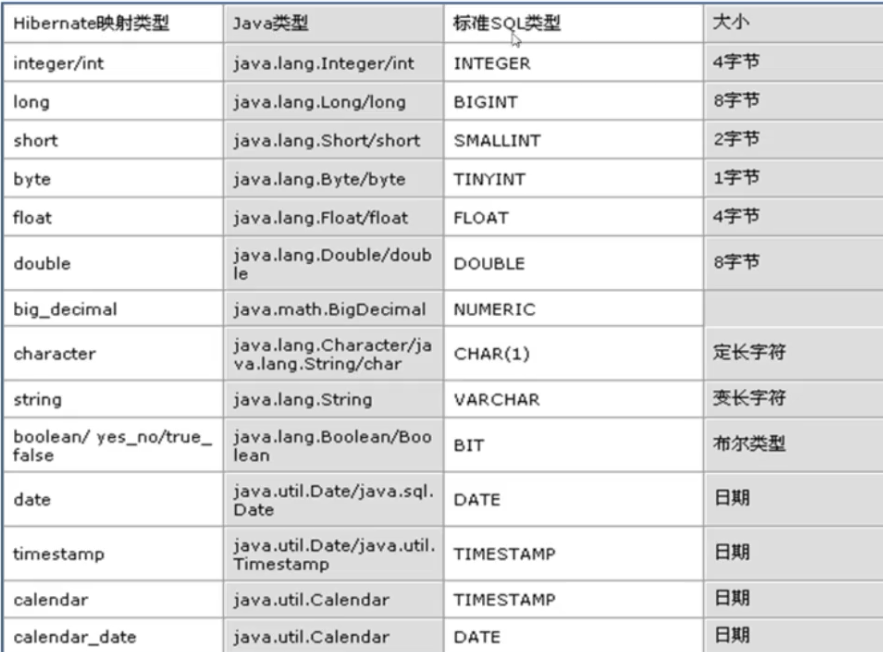Hibernate的基本用法
2017-03-30 13:27
316 查看
Hibernate 的基本开发步骤
1.编写配置文档hibernat.cfg.xml
例如:<session-factory> <!--数据库用户名--> <property name="connection.username">root</property> <!--数据库登录密码--> <property name="connection.password">123456</property> <!--jdbc驱动 --> <property name="connection.driver_class">com.mysql.jdbc.Driver</property> <!--设置端口 字符集等 --> <property name="connection.url">jdbc:mysql://127.0.0.1:3306/hibernate?useUnicode=true&characterEncoding=utf-8</property> <!--方言 --> <property name="dialect">org.hibernate.dialect.MySQLDialect</property> <!--是否直接打印出sql语句 --> <property name="show_sql">true</property> <!--sql格式 --> <property name="format_sql">true</property> <!--ddl生成策略--> <property name="hbm2ddl.auto">update</property> <!--对应的映射 --> <mapping resource="Students.hbm.xml"/> </session-factory>
单一主键:
1.assigned 由java应用程序负责生成(手工赋值)
2.native 由底层数
b568
据库自动生成标示符,如果是MySQL就是increment,如果是Oracle就是sequence,等等
Ps1:assigned注意:如果实体类中设置的主键id是基本类型int的话,则可以不用赋值,系统默认值为0;如是引用类型Integer话,则默认值为null,不赋值系统则报错。
Ps2:native注意:系统会自动选择该数据库对应的自动增值方式,从1开始。即使手动给他赋值,也不会起作用,但也不会报错。

2.编写实体类
需要符合JAVA BEAN 规范 即:1、公有的类。
2、提供公有的不带参数的默认的构造方法。
3、属性私有。
4、属性setter/getter封装
3.生成对应实体类的映射文件
可在包上鼠标右键,点击new->other->Hibernate->Hibernate XML Mapping file(hbm.xml)自动创建如:
<hibernate-mapping> <class name="Students" table="STUDENTS"> <id name="id" type="int"> <column name="ID" /> <!--主键策略--> <generator class="assigned" /> </id> <property name="sname" type="java.lang.String"> <column name="SNAME" /> </property> ...................... <!-- <property name="address" type="java.lang.String"> <column name="ADDRESS" /> </property> --> <property name="picture" type="java.sql.Blob"> <column name="PICTURE" /> </property> <component name="address" class="Address"> <property name="postcode" column="POSTCODE"/> <property name="phone" column="PHONE"/> <property name="address" column="ADDRESS"/> </component> </class> </hibernate-mapping>
常用配置如下:
4.调用Hibernate API进行测试
例如:import java.io.File;
import java.io.FileInputStream;
import java.io.FileOutputStream;
import java.io.InputStream;
import java.io.OutputStream;
import java.sql.Blob;
import java.util.Date;
import org.hibernate.Hibernate;
import org.hibernate.Session;
import org.hibernate.SessionFactory;
import org.hibernate.Transaction;
import org.hibernate.cfg.Configuration;
import org.hibernate.service.ServiceRegistry;
import org.hibernate.service.ServiceRegistryBuilder;
import org.junit.After;
import org.junit.Before;
import org.junit.Test;
//测试类
public class StudentsTest {
private SessionFactory sessionFactory;
private Session session;
private Transaction transaction;
@Before
public void init(){
//创建配置对象
Configuration config = new Configuration().configure();
//创建服务注册对象
ServiceRegistry serviceRegistry = new ServiceRegistryBuilder().applySettings(config.getProperties()).buildServiceRegistry();
//创建会话工厂对象
sessionFactory = config.buildSessionFactory(serviceRegistry);
//会话对象
session = sessionFactory.openSession();
//开启事务
transaction = session.beginTransaction();
}
@After
public void distory(){
//提交事务
transaction.commit();
session.close();
sessionFactory.close();
}
@Test
public void testSaveStudents(){
//生成学生对象
Students s = new Students(1,"小明","男",new Date());
Address address = new Address("312312","09876666","杭州");
s.setAddress(address);
session.save(s);//保存对象进入数据库
}
@Test
public void testWriteBlob()throws Exception{
Students s = new Students(4,"小明","男",new Date());
//获得照片文件
File f = new File("f:"+File.separator+"头像.jpg");
//获得输入流
InputStream input = new FileInputStream(f);
//创建一个Blob对象
Blob image = Hibernate.getLobCreator(session).createBlob(input, input.available());
//设置照片属性
s.setPicture(image);
//保存学生
session.save(s);
}
@Test
public void testReadBlob()throws Exception
{
Students s = (Students) session.get(Students.class, 4);
//获得blob对象
Blob image =s.getPicture();
//创建输入流
InputStream input = image.getBinaryStream();
//创建输出流
File f = new File("f:"+File.separator+"头像2.jpg");
OutputStream output = new FileOutputStream(f);
//缓冲区
byte[] buff = new byte[input.available()];
input.read(buff);
output.write(buff);
input.close();
output.close();
}Hibernate其他一些基础知识
transaction:事务
Hibernate对数据的操作都是封装在事务当中,并且默认是非自动提交的方式。所以用session保存对象时,如果不开启事务,并且手工提交事务,对象并不会真正保存在数据库中 如上例中的://开启事务 transaction = session.beginTransaction(); //提交事务 transaction.commit();
session
1.getCurrentSession在事务提交或者回滚之后会自动关闭,而openSesssion需要你手动关闭。如果使用openSession而没有手动关闭,多次之后会导致连接池溢出!
2.openSession每次创建新的session对象,
getCurrentSession使用现有的session对象(现有session没commit之前)
基本类型

对象类型

注:本文图片等部分来源于慕课网教程=.=
相关文章推荐
- Hibernate的一些基本用法
- Hibernate中的Query一些基本用法
- Hibernate的基本API的用法
- 5 -- Hibernate的基本用法 --1 3 流行的ORM框架简介
- 5 -- Hibernate的基本用法 --1 2 基本映射方式
- Hibernate中的Query一些基本用法
- 5 -- Hibernate的基本用法 --2 2 Hibernate的数据库操作
- Hibernate中的Query一些基本用法
- Java的Hibernate框架中的基本映射用法讲解
- 5 -- Hibernate的基本用法 --2 Hibernate入门
- (转)Hibernate中的Query一些基本用法
- 第5章Hibernate的基本的用法5.5深入理解持久化对象
- 第5章Hibernate的基本用法 5.4深入Hibernate的配置文件
- Hibernate-Usage(basis)(hibernate基本用法)
- 【Java EE (Struts2 + Spring + Hibernate)开发】系列之 Spring(一)基本用法
- Hibernate中的Query一些基本用法
- 第5章 HIbernate的基本用法 5.3Hibernate的体系结构
- 【Java EE (Struts2 + Spring + Hibernate)开发】: Struts2(一)基本用法(待续)
- 5 -- Hibernate的基本用法 --1 ORM和Hibernate
- 5 -- Hibernate的基本用法 --2 1 Hibernate 下载和安装
